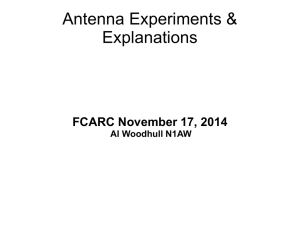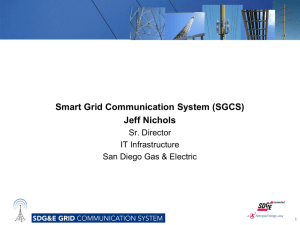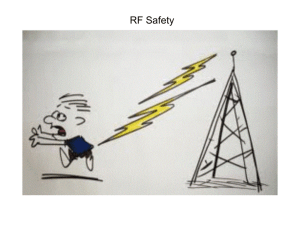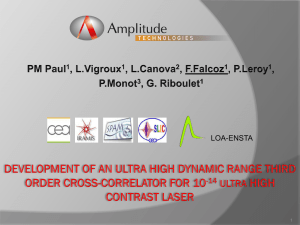Itzler - InP-SPAD Afterpulsing SPW2011
advertisement
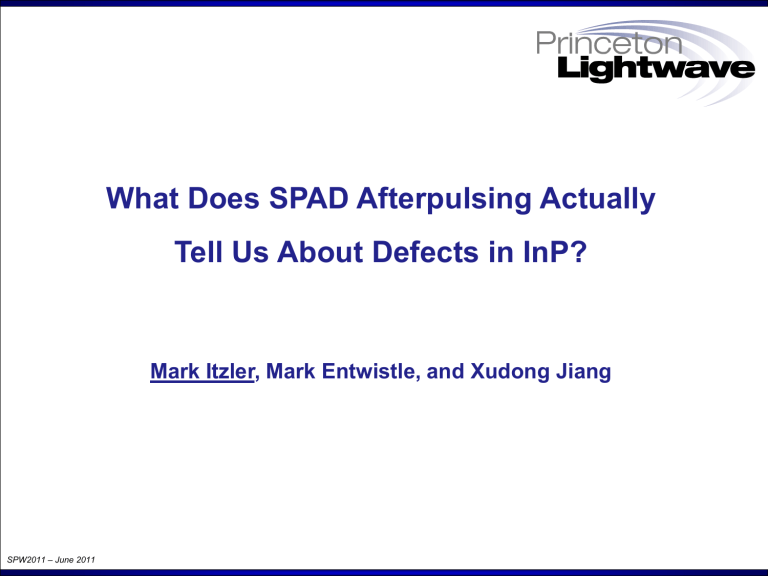
What Does SPAD Afterpulsing Actually Tell Us About Defects in InP? Mark Itzler, Mark Entwistle, and Xudong Jiang SPW2011 – June 2011 Presentation Outline 50 MHz photon counting with RF matched delay line scheme Afterpulse probability (APP) dependence on hold-off time Fitting of APP data inadequacy of legacy approach assuming one or few traps new fitting based on broad trap distribution Implications of APP modeling for trap distributions Summary SPW2011 – June 2011 Princeton Lightwave Inc. 2 Afterpulsing: increased DCR at high rate Single photon detection by avalanche multiplication in SPADs Avalanche carriers trapped at defects in InP multiplication region Carrier de-trapping at later times initiates “afterpulse” avalanches Serious drawback of afterpulsing → limitation on counting rate SiNx passivation p-contact metallization + E p -InP diffused region i-InP cap # of trapped carriers multiplication region n-InP charge n-InGaAsP grading i-InGaAs absorption primary avalanche + n -InP buffer + n -InP substrate anti-reflection coating short hold-off time n-contact metallization optical input afterpulses trap sites located in multiplication region # of trapped carriers Ec Ev Long hold-off time SPW2011 – June 2011 Princeton Lightwave Inc. 3 New results for RF delay line circuit Enhance matched delay line circuit to operate at higher repetition rate Inverted and non-inverted RF reflections cancel transients Based on existing PLI product platform Cancel transient response synchronous with photon arrival Temporally gate out leading and trailing transients Set threshold for remaining avalanche signal Bethune and Risk, JQE 36, 340 (2000) SPW2011 – June 2011 Princeton Lightwave Inc. 4 Matched delay line solution to 50 MHz Extension of cancellation scheme to higher frequencies More precise cancellation for reduced detection threshold → detect smaller avalanches Higher speed components to enable 50 MHz board-level operation Measure cumulative afterpulsing using odd gates “lit”, even gates “dark” Take all counts in even gates above dark count background to be afterpulses 1E+0 NEW Performance (1 ns gate duration) OLD Performance (1 ns gate duration) 1E-1 1E-2 1E-3 10 MHz 5 MHz 2 MHz 1 MHz 0.5 MHz 1E-4 1E-5 PER DETECTED PHOTON 1E-2 1E-3 50 MHz 33 MHz 10 MHz 1 MHz 1E-4 1E-6 5% • Afterpulse Probability Afterpulse Probability (per 1 ns gate pulse) 1E-1 10% 15% 20% 25% Photon Detection Efficiency 30% 0% 10% 20% 30% Photon Detection Efficiency 40% Absence of afterpulsing “runaway” indicates higher frequencies can be achieved SPW2011 – June 2011 Princeton Lightwave Inc. 5 “Double-pulse” afterpulse measurement Use “time-correlated carrier counting” technique to measure afterpulses Trigger single-photon avalanches in 1st gate Measure probability of afterpulse in 2nd gate at Tn Use range of Tn to determine dependence of afterpulse probability on time following primary avalanche Cova, Lacaita, Ripamonti, EDL 12, 685 (1991) T1 ≈ T2 Afterpulse probability Double-pulse (“pump-probe”) method ≈ T1 T2 Time SPW2011 – June 2011 Princeton Lightwave Inc. 6 FPGA-based data acquisition Use FPGA circuitry to control gating and data collection Generalize double-pulse method to many gates Capture afterpulse counts in up to 128 gates following primary avalanche Temporal spacing of gates determined by gate repetition rate Allows capture of afterpulse count in any gate after avalance No need to step gate position as in double-pulse method 1 ns gates 20 ns ≈ 50 MHz: 1 2 3 4 5 6 126 127 128 1 2 40 ns ≈ 25 MHz: 1 SPW2011 – June 2011 2 3 128 Princeton Lightwave Inc. 1 7 FPGA-based afterpulse measurements Obtain afterpulsing probability data at 5 frequencies for 128 gates 1E-2 1E-3 1E-4 33 MHz 1E-5 100 1000 Time following primary avalanche (ns) 1E-1 1E-2 1E-3 1E-4 25 MHz 100 1000 Time following primary avalanche (ns) 1E-1 40 MHz All frequencies 1E-2 1E-3 1E-4 40 MHz 1E-5 10 100 1000 Time following primary avalanche (ns) 1E-1 50 MHz 1E-2 1E-3 1E-4 1E-1 10 MHz 1E-2 1E-3 1E-4 10 MHz 1E-5 10 Afterpusle probability per detected photon per gate Afterpusle probability 25 MHz 1E-5 10 Afterpusle probability 1E-1 Afterpusle probability 33 MHz Afterpusle probability Afterpusle probability 1E-1 10 100 1000 Time following primary avalanche (ns) PDE = 20% 1 ns gates 1E-2 APP ~ 1% at 30 ns 1E-3 50 MHz 40 MHz 33 MHz 25 MHz 10 MHz 1E-4 50 MHz 1E-5 1E-5 10 100 1000 Time following primary avalanche (ns) SPW2011 – June 2011 10 100 1000 Time following primary avalanche (ns) Princeton Lightwave Inc. 8 Legacy approach to afterpulse fitting Try to fit afterpulse probability (APP) data with exponential fit Physically motivated by assumption of single dominant trap APP1 exp(-t/τ1) 1E-1 Afterpusle probability per detected photon per gate PDE = 20% 1 ns gates Single exponential curve generally fits range of ~5X in time 1E-2 1E-3 50 MHz 40 MHz 33 MHz 25 MHz 10 MHz 1E-4 1E-5 10 SPW2011 – June 2011 100 1000 Time following primary avalanche (ns) Princeton Lightwave Inc. 9 Legacy approach to afterpulse fitting Try to fit afterpulse probability (APP) data with exponentials Physically motivated by assumption of single dominant trap Single exponential not sufficient; assume second trap APP2 exp(-t/τ2) 1E-1 Afterpusle probability per detected photon per gate PDE = 20% 1 ns gates Single exponential curve generally fits range of ~5X in time 1E-2 1E-3 50 MHz 40 MHz 33 MHz 25 MHz 10 MHz 1E-4 1E-5 10 SPW2011 – June 2011 100 1000 Time following primary avalanche (ns) Princeton Lightwave Inc. 10 Legacy approach to afterpulse fitting Try to fit afterpulse probability (APP) data with exponentials Physically motivated by assumption of single dominant trap Single exponential not sufficient; assume second trap Still need third exponential to fit full data set APP3 exp(-t/τ3) 1E-1 Afterpusle probability per detected photon per gate PDE = 20% 1 ns gates Single exponential curve generally fits range of ~5X in time 1E-2 1E-3 50 MHz 40 MHz 33 MHz 25 MHz 10 MHz 1E-4 1E-5 10 SPW2011 – June 2011 100 1000 Time following primary avalanche (ns) Princeton Lightwave Inc. 11 Legacy approach to afterpulse fitting Can achieve reasonable fit with several exponentials …but choice of time constants is completely arbitrary! → depends on range of times used in data set Our assertion: No physical significance to time constants in fitting → simply minimum set of values to fit the data set in question Afterpusle probability per detected photon per gate 1E-1 PDE = 20% 1 ns gates 1E-2 APP = C1exp(-t/τ1) + C2exp(-t/τ2) + C3exp(-t/τ3) τ1 = 30 ns 1E-3 τ2 = 120 ns 50 MHz 40 MHz 33 MHz 25 MHz 10 MHz 1E-4 1E-5 10 SPW2011 – June 2011 τ3 = 600 ns 100 1000 Time following primary avalanche (ns) Princeton Lightwave Inc. 12 What other functions describe APP? Good fit for simple power law T-α with α ≈ -1 → Is power law behavior found for other afterpulsing measurements? → Is the power law functional form physically significant? Afterpusle probability per detected photon per gate 1E-1 y = 0.52x-1.07 PDE ~ 20% 1 ns gates 1E-2 APP = C T-α 1E-3 50 MHz 40 MHz 33 MHz 25 MHz 10 MHz 1E-4 1E-5 10 SPW2011 – June 2011 100 1000 Time following primary avalanche (ns) Princeton Lightwave Inc. 13 Afterpulsing data from Univ. Virginia Good fit for power law T-α with α ≈ -1.0 to -1.1 data from Joe Campbell, UVA 1E+0 Afterpulse probability y = 3.44x-1.03 y= 1E-1 2.20x-1.05 UVA data ~30% PDE y = 0.74x-1.09 Double-pulse method PLI SPADs 1E-2 1E-3 3 ns gate 2 ns gate 1 ns gate 1E-4 10 100 1000 Time following primary avalanche (ns) SPW2011 – June 2011 Princeton Lightwave Inc. 14 Afterpulsing data from NIST Good fit for power law T-α with α ≈ -1.15 to -1.25 data from Alessandro Restelli and Josh Bienfang, NIST 1E+0 NIST data y = 2.92x-1.16 Afterpulse Probability ~15% PDE y = 0.49x-1.21 1E-1 Double-pulse method 1E-2 PLI SPADs 1E-3 1E-4 1.50 ns gate 1.00 ns gate 0.63 ns gate 0.50 ns gate 1E-5 1E-6 1 y = 0.13x-1.24 y = 0.06x-1.25 10 100 1000 Time following primary avalanche (ns) SPW2011 – June 2011 Princeton Lightwave Inc. 15 Afterpulsing data from Nihon Univ. Good fit for power law T-α with α = -1.38 data from Naota Namekata, Nihon U. Normalized Afterpulse Probability 1 Nihon U. data 213 K Autocorrelation test of timetagged data 0.1 PLI SPADs y = 237.66x-1.38 0.01 0.001 10 SPW2011 – June 2011 100 1000 Time following primary avalanche (ns) Princeton Lightwave Inc. 16 Literature on InP trap defects Literature on defects in InP describes dense spectrum of levels Instead of assuming one or a few dominant trap levels: → consider implications of a broad distribution for τ Deep-level traps in multiplication region Ec – 0.24 eV Ec – 0.30 eV Ec – 0.37 eV Ec – 0.40 eV SiNx passivation p-contact metallization p+-InP diffused region Electric field i-InP cap Ec – 0.55 eV multiplication region n-InP charge n-InGaAsP grading i-InGaAs absorption + n -InP buffer + n -InP substrate anti-reflection coating n-contact metallization Early work Later work Radiation effects optical input W. A. Anderson and K. L. Jiao, in “Indium Phosphide and Related Materials: Processing, Technology, and Devices”, A. Katz (ed.) (Artech House, Boston, 1992) SPW2011 – June 2011 Princeton Lightwave Inc. 17 Implications of trap distribution on APP Develop model for APP with distribution of detrap rates R ≡ 1/τ – APP related to change in trap occupation: dN/dt ~ R exp(-t R) – Integrate over detrapping rate distribution D(R) → APP ~ ∫ dR D(R) R exp(-t R) D(R) narrowest distribution “Uniform” R R0 R Normal D(R) SPW2011 – June 2011 D(R) δ(R – R0) single trap R0 D(R) R Princeton Lightwave Inc. widest distribution “Inverse” D(R) α 1/R R 18 Implications of trap distribution on APP “Single trap” leads to exponential behavior – Fitting requires multiple exponentials and is arbitrary Normal distribution is similar to single trap – Gaussian broadening of δ(R – R0) doesn’t change exponential behavior “Uniform” and “inverse” distributions can be solved analytically – Require assumptions for a few model parameters Minimum detrapping time: Maximum detrapping time: Number of trapped carriers: Detection efficiency: SPW2011 – June 2011 τmin = 10 ns τmax = 10 µs n=5 20% Princeton Lightwave Inc. just sample values; can be generalized 19 Modeling results for APP APP results for Uniform and Inverse detrap rate distributions D(R) APP behavior fit well by T-α for 10 ns to 10 µs – Value of α depends on model parameter values, but α is well-bounded Normalized afterpulsing probability 1E+0 Inverse 1E-1 y = 25.23x-1.18 1E-2 Inverse D(R): y = 200.93x-2.00 1E-3 T-α with 1.05 < α < 1.30 1E-4 Uniform Uniform D(R): 1E-5 T-α with 1.9 < α < 2.1 1E-6 10 SPW2011 – June 2011 100 1000 Time following primary avalanche (ns) Princeton Lightwave Inc. 10000 20 Insights from modeling of APP Inverse distribution provides correct power law behavior – More traps with slower release rates D(R) α 1/R D(R) – Other distributions considered do not agree with data Inverse distribution not necessarily a unique solution R – But it provides more accurate description than single trap or uniform Slower falloff of APP with hold-off time for Inverse distribution – Need longer hold-off times to achieve same relative decrease in total AP Other possible explanations for power law behavior to explore – Role of field-assisted detrapping, especially in non-uniform E-field – Model in literature cites power law behavior for “correlated” detrapping A. K. Jonscher, Sol. St. Elec. 33, 139 (1990) SPW2011 – June 2011 Princeton Lightwave Inc. 21 Afterpulsing data on Silicon SPADs Neither power law nor exponential provide particularly good fit! Nature of defects in Si SPADs may be categorically different than for InP Afterpulsing Probability Density (ns-1) -2 1.E-02 10 data from Massimo Ghioni, Politecnico di Milano Power law Silicon SPADs T = -25 C, Pap = 6% y = 0.21x-1.54 -3 1.E-03 10 Double-pulse method -4 1.E-04 10 -5 1.E-05 10 y = 0.0002e-0.005x Exponential -6 1.E-06 10 -7 1.E-07 10 10 100 1000 Time (ns) SPW2011 – June 2011 Princeton Lightwave Inc. 22 Summary Reached 50 MHz photon counting with RF matched delay line scheme Significant further repetition rate increases should be feasible Fitting of APP data with multiple exponentials not physically meaningful Extracted detrapping times are arbitrary, depend on hold-off times used Literature on defects in InP suggests possibility of broad distribution of defects Consistent power law behavior of APP data found by various groups APP vs. time T described by T-α with α ~ 1.2 ± 0.2 Assumption of “inverse” distribution D(R) α 1/R for detrapping rate R provides best description of data among distributions considered so far Not unique, but establishes general behavior May be other models that predict power law APP behavior for dominant trap Further modeling can predict behavior for different operating conditions SPW2011 – June 2011 Princeton Lightwave Inc. 23 BACK-UP SLIDES SPW2011 – June 2011 Princeton Lightwave Inc. 24 Electric field engineering in APDs Vertical structure to realize SAGCM structure for well-designed APD Multiplication gain: high field for impact ionization Carrier drift in absorber: low but finite absorber field Avoid of tunneling in all layers Eliminate interface carrier pile-up Control of 3-D electric field distribution to avoid edge breakdown p-contact metallization SiNx passivation p+-InP diffused region E i-InP cap multiplication region n- InP charge n -InGaAsP grading i- InGaAs absorption + n -InP buffer + n -InP substrate anti-reflection coating n-contact metallization optical input SPW2011 – June 2011 Princeton Lightwave Inc. Schematic design for InGaAs/InP SPAD for 1.5 μm photon counting 25

